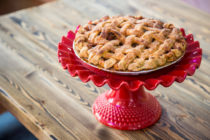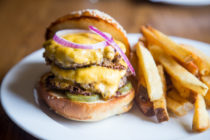Houston knife maker Russell Montgomery of Serenity Knives isn’t restrained when it comes to stressing the importance of sharpening and maintaining your knives. “If you smell onions on the cutting board, your knife is dull. Onions only smell in the frying pan.” Lesson learned – no one enjoys crying over chopped onions.
So what is the best method for sharpening your kitchen knives? We swung by Montgomery’s knife shop in The Heights and asked him to show us. Montgomery doesn’t suggest using a steel or hone; rather he uses three Japanese waterstones, each with a different grit – one for sharpening (1000 grit), one for maintaining (4000 grit) and one for polishing (8000 grit). The higher the grit, the less material will be removed from the knife. Be sure to soak the stones in water for the recommended time (typically five to 10 minutes).
It’s important to understand that sharpening and maintaining knives are two different things. If the knife still has an edge, you do not need to use the 1000 grit stone to sharpen the knife. Instead, maintain and restore the cutting edge with a 4000 grit stone.
Place the stone, which will likely come in a hinged box, in a sheet pan and place the pan against the back of a counter for stability. Stroke the knife against the stone in a sweeping motion with light pressure, leading with the spine and being careful not to push the edge into the stone. If you maintain the knife’s edge once a week or once every other week, five to 10 strokes on each side of the blade will do. You can then polish the knife with the 8000 grit stone, using the same sweeping motion with lighter pressure, for a razor-sharp edge and mirror-like finish.
If the knife’s edge is completely dull, you need to sharpen and re-establish the edge with the 1000 grit stone. When you are sharpening, you are essentially putting an edge back on the knife by removing material. Place the knife on the stone and tilt the knife at a 10 to 15 degree angle so the edge touches the stone. There are tricks to getting the right angle, such as placing two pennies or a book of matches underneath the knife. Move the knife back and forth, applying even pressure with your fingers and keeping the angle consistent. Be patient and remember you can always remove more material, so begin with light pressure and apply more accordingly. Once you have established an edge, move on to the 4000 grit stone to further sharpen and 8000 grit stone for a shiny knife edge.
There is a reason many of us – including restaurant chefs – send our knives to be sharpened by professionals. It takes patience and a certain finesse. Watch Montgomery sharpen and polish a knife in the video below.








Follow Us